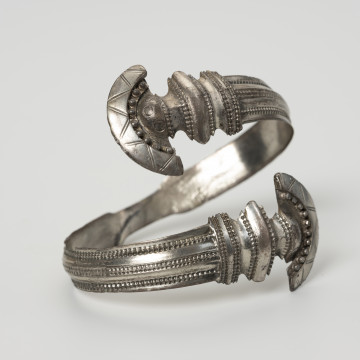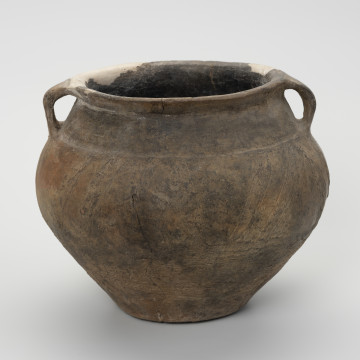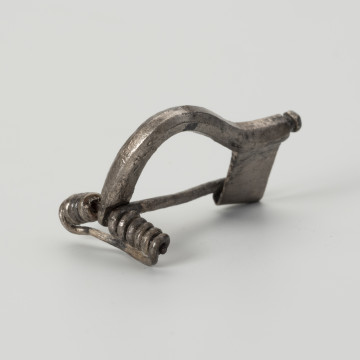
Wave bracelet
150 — 200
National Museum in Szczecin
Part of the collection: Antiquity
A silver wave bracelet, with a clasp decorated with filigree and pearl wire, was part of the rich accessories found in an inhumation burial of a female, who probably died of old age. Her funerary offering also included a second silver wave bracelet with an undecorated clasp, two twin silver snake-head bracelets, and six silver and bronze clasps decorated with applications in silver and gold, including filigree and ornamented plates. Furthermore, the burial included a fragment of a bronze pin, a small clay vessel, a bronze belt buckle, two gold wire beads, and a gold S-shaped buckle decorated with filigree. Weaving artefacts such as a decorated clay spindle whorl, fragments of a distaff with bronze fittings, and a bronze hooked pin were also part of the burial attributes. Dated to the 2nd half of the 2nd century AD, the grave, documented under the number 4, was covered with a barrow number 22 together with four other inhumation burial sites, discovered in a cemetery in Gronowo (municipality of Złocieniec, Drawsko district, West Pomeranian Province; German name: Groß Grünow, Kr. Dramburg). The first investigator of the barrow necropolis accidentally found in 1881 was Pastor Plato from nearby Złocieniec, who conducted amateur excavations in 1881, 1887, and 1890 on the only part of the cemetery which was identified at that time. Another grave complex was discovered in 1926 while constructing a road to Złocieniec. It was an inhumation burial with Roman imports as grave goods. Between 1939 and 1940, several pit graves were encountered during the construction of the Berlin-Szczecin-Gdańsk motorway. These were excavated by local archaeologists Heinz Hinz and Dr. Faust. Shortly afterward, the area of the cemetery was reforested, as the construction of the motorway mentioned above was abandoned between 1940 and 1941. Methodical excavations did not take place until between 1973 and 1977 under the supervision of Ryszard Wołągiewicz from the museum in Szczecin. It was during these excavations that the described grave and the presented wave fibula were discovered. In total, 56 urned cremations and inhumations, including 49 covered by barrow mounds, were found in Gronów, which is now regarded as one of the most important sites of the Wielbark culture in Pomerania. Bartłomiej Rogalski
Author / creator
Object type
wave bracelet, forearm adornment
Technique
casting, forging
Material
silver
Origin / acquisition method
field research
Creation time / dating
Creation / finding place
Owner
Muzeum Narodowe w Szczecinie
Identification number
Location / status

150 — 200
National Museum in Szczecin

150 — 200
National Museum in Szczecin

150 — 250
National Museum in Szczecin
DISCOVER this TOPIC
Castle Museum in Łańcut
DISCOVER this PATH
Educational path